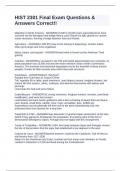HIST 2301 Final Exam Questions &
Answers Correct!!
Migration to North America - ANSWER(12,000 to 40,000 years ago) believed to have
occurred via the Beringian land bridge theory, post-Glacial ice age; glacial ice caused
ocean recession, forming a bridge between Asia and Alaska
Agriculture - ANSWER(7,000 BC) Due to this industry's beginnings, Archaic Indian
tribes grew larger and more organized
Maize, beans, and squash - ANSWERformed what is known as the American Triad
(plants)
Cahokia - ANSWERfirst occupied in AD 700 and lasted approximately four centuries, its
peak population was 20,000 and was the most extensive urban center in prehistoric
America. The eventual environmental degradation led to the downfall of these ancient
peoples. Known for their mounds atop which they built structures
Karankawa - ANSWERMeans "dog lover"
Ranged from Galveston to Corpus Christi
Tall, regularly 6ft or taller, good swimmers, used dugout canoes, longbow hunters, ate
marine life (fish oysters, clams, scallops), and adorned themselves with tattoos and
piercings
Lived near the Gulf and were fishers.
Coahuiltecans - ANSWERTall, strong swimmers, longbow hunters, nomads, used body
modification, and were fast runners
Lived inland and were hunter-gatherers with a diet consisting of desert flora and fauna:
cacti, lizards, small birds, rabbits, mice, frogs, armadillos, deer, buffalo etc.
Superstitious and ritualistically left their sick to die alone (abandoning evil); this
protected them from disease for a long time
Papal Bull of 1493 - ANSWERPope Alexander VI granted Spain possession of the New
World if they agreed to Christianize the population. Everything west of this line of
demarcation belonged to Spain; Portugal was not happy with this arrangement
Treaty of Tordesillas - ANSWERIn 1494, this treaty between Spain and Portugal, moved
the line of demarcation that the pope had established a few degrees to the west
Cabeza de Vaca - ANSWERSpanish explorer; explored the Caribbean, Gulf of Mexico,
and Mexico from 1527-1536
Made it to the Dominican and Cuba, crashed and lost many crew members in Florida
Landed in Galveston in 1528 and lived among the Coahuiltecans
, Eventually makes his way back to Mexico, then Spain, where he wrote about his
adventures
Martin Luther - ANSWERCompiled a list of Church reforms, a document that came to be
known as The Ninety-Five Theses in 1517: publication of the Bible in everyday
language, no imposing tithe, and no buying and selling of indulgences
Unintentionally began the Protestant Reformation that divided the Church in two
Lack of immigrational "pull" factors to Spanish Texas - ANSWERNo infrastructure = no
safety Hostile Indians: some were cannibals, most were aggressive
No gold or silver had been found in the New World
Primary immigrational "push" factors to Spanish Texas - ANSWERThe Papal Bull of
1493: many Christians felt it was their duty to Christianize the Indians
Protect the area from the French encroaching on the region
Missions - ANSWERchurch owned and controlled, goal was to Christianize Indians
Presidios - ANSWERgovernment-controlled fort with soldiers, goal was to protect the
missions and future settlers
Ranchos - ANSWERcivilian-owned homesteads granted by the king to settlers that
focused on raising livestock
Farms - ANSWERcivilian-owned agricultural homesteads granted by king to farmers
Comanche - ANSWERThrived in Texas prior to Spanish exploration, hunted the
Apaches (especially the Lipan Apache)
Armed and mounted ____________ became a formidable force in Texas until they
signed the Spanish-____________ Treaty of 1785
Mestizo - ANSWERa person of combined European and Indigenous American descent
Bourbon Reforms - ANSWERSent Jose De Galvez to:
-investigate the political structure of Mexico
-replace Mexican leaders with Spanish
-lower taxes
-enforce free trade
Sent Marquis de Rubi to:
-investigate the military structure of Mexico
-abandon Nacogdoches
-move to San Antonio
-develop friendly relations with the Comanches
-take a firm stand against the Apache




